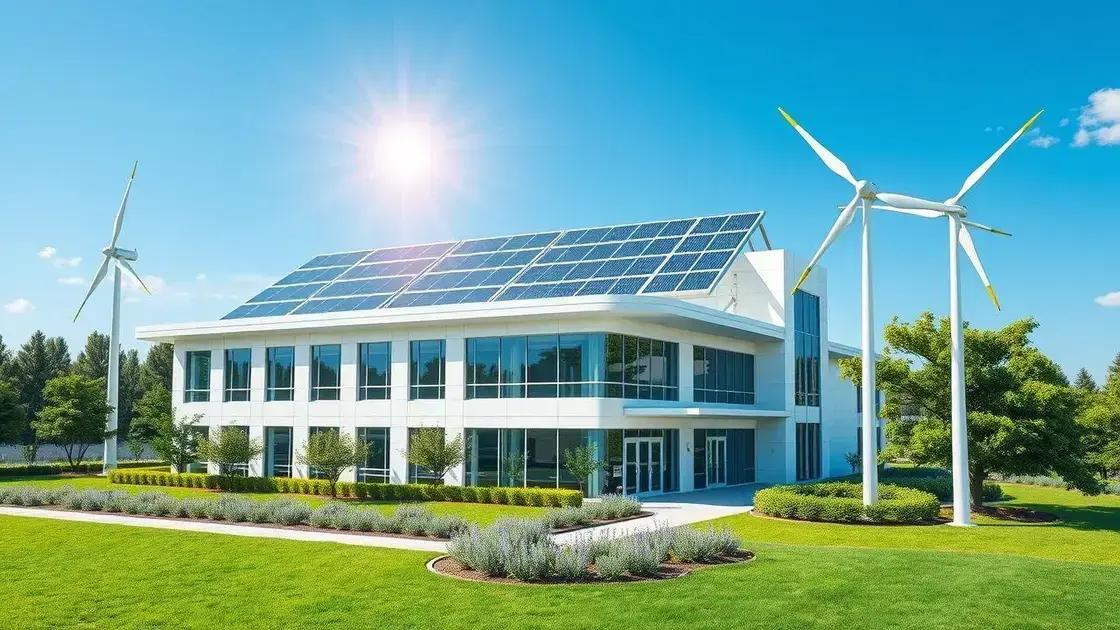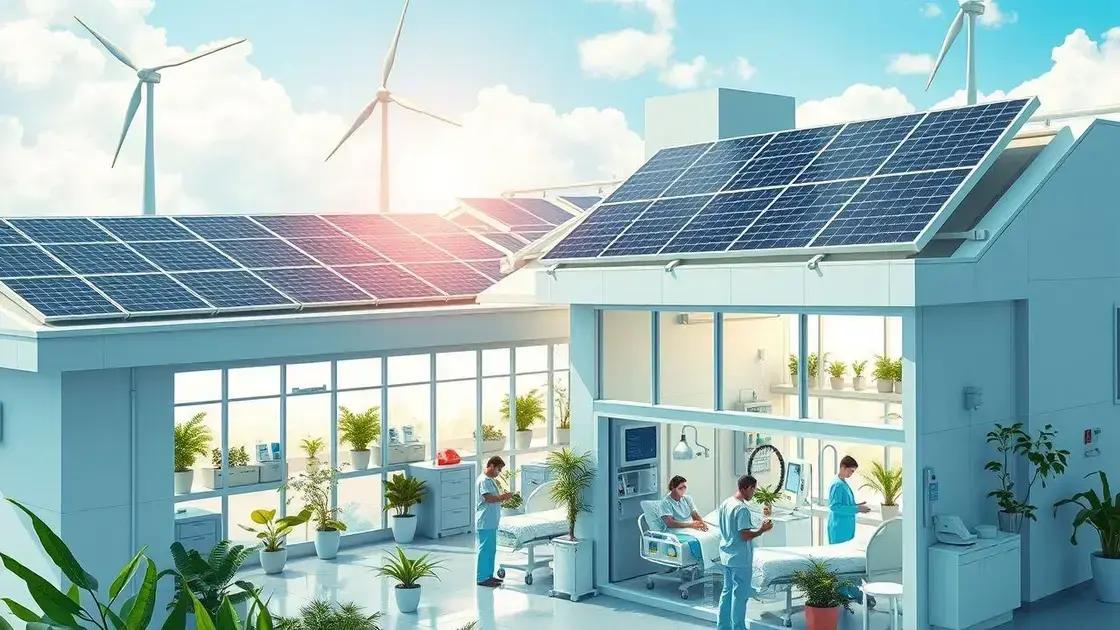Energy healthcare system news: what’s changing now?

The energy healthcare system integrates renewable energy technologies to enhance patient care, reduce operational costs, and promote sustainability within healthcare facilities.
Energy healthcare system news is reshaping how we think about patient care. With advancements in technology and sustainability, there’s a lot to explore. What does this mean for you? Let’s dive into the latest developments!
Understanding the energy healthcare system
Understanding the energy healthcare system is crucial for grasping how healthcare facilities operate efficiently today. This system combines energy sources and healthcare solutions to enhance patient care and manage resources effectively.
One key aspect is the integration of renewable energy sources. Hospitals and clinics are increasingly adopting solar panels and wind turbines. This shift not only reduces operational costs but also lowers their carbon footprint.
The benefits of using renewable energy
There are several advantages to implementing renewable energy in healthcare:
- Lower energy bills: Sustainable energy can lead to significant savings over time.
- Improved patient care: More reliable energy sources ensure that critical systems remain operational.
- Environmental impact: Reducing emissions contributes positively to public health.
Many facilities are also exploring energy-efficient technologies. These include smart thermostats and LED lighting, which can lower energy usage significantly.
The energy healthcare system also focuses on resilience. In case of outages, backup energy systems are vital. This ensures that healthcare providers can continue operating without interruptions.
With advances in energy technology, healthcare facilities can now monitor their energy consumption in real-time. This helps identify areas for improvement and optimize energy use.
Challenges in energy healthcare integration
Despite the benefits, integrating these systems can be challenging. For instance, initial setup costs for renewable systems can be high. However, many find the long-term savings justify these upfront expenses.
Another obstacle is the need for staff training. It’s essential that healthcare professionals understand how to use new technologies effectively.
As we continue to develop better energy solutions, the synergy between energy and healthcare will benefit both patients and providers alike.
Recent innovations in energy for healthcare
Recent innovations in energy for healthcare are transforming how medical facilities operate. These advancements aim to enhance efficiency and patient care while reducing environmental impacts.
One exciting development is the emergence of smart grids. These systems allow healthcare facilities to manage their energy consumption better. By using real-time data, hospitals can reduce energy waste during low-demand hours.
Key innovations in energy solutions
Several new technologies are making a big difference in energy management:
- Energy storage systems: These systems store excess energy for later use, which helps maintain a steady power supply during peak times.
- Microgrid technology: Microgrids enable facilities to generate their energy locally. This can reduce dependence on larger grid systems and improve resilience.
- Smart building technology: From HVAC systems to lighting, smarter technologies optimize energy use in real time, creating a more comfortable environment for patients and staff.
Another innovative trend is the use of biomass energy. Some healthcare facilities harness organic waste to produce energy. This renewable approach reduces waste and provides a sustainable energy source.
Moreover, hospitals are investing in energy audits. These assessments help identify energy-saving opportunities in their operations. By pinpointing inefficiencies, facilities can implement changes that cut costs and boost sustainability.
Impact on patient care
With these innovations, healthcare providers can deliver better services. Reliable energy supply ensures that critical medical equipment remains operational. This directly impacts patient safety and treatment outcomes.
As hospitals embrace these technologies, they not only enhance their performance but also contribute to a greener planet. By focusing on sustainability, healthcare facilities can play a significant role in protecting the environment.
The impact of renewable energy on patient care

The impact of renewable energy on patient care is becoming increasingly important in today’s healthcare environment. By integrating sustainable energy sources, healthcare facilities are not only reducing their carbon footprint but also enhancing the quality of care they provide.
One major benefit is the improved reliability of energy supply. Renewable energy sources, such as solar and wind, can provide consistent power. This is essential for critical care services that depend on uninterrupted power for medical equipment.
Benefits of renewable energy in healthcare
Adopting renewable energy directly affects several areas of patient care:
- Enhanced safety: Hospitals powered by renewable energy reduce the risk of outages that can disrupt patient services.
- Better facilities: With lower energy costs, funds can be redirected toward improving healthcare services and upgrading medical equipment.
- Healthier environments: Using clean energy sources minimizes harmful emissions, providing a healthier atmosphere for patients and staff.
Moreover, facilities that utilize renewable energy often teach patients about sustainability. This can foster a culture of health and awareness about environmental issues among patients and communities.
In addition, integrating renewable energy can improve patient experience by creating a more comfortable environment. For example, smart climate control systems can maintain optimal temperatures while using less energy.
Challenges and considerations
Despite the many benefits, there are challenges in implementing renewable energy solutions. For example, the initial investment can be high, but many facilities recognize that long-term savings and improved patient care offset these costs.
Training staff to efficiently use and maintain these new systems is also crucial. With proper education, healthcare providers can maximize the impact of renewable energy on patient care.
Challenges faced in the energy healthcare transition
Challenges faced in the energy healthcare transition can impact how effectively facilities adopt sustainable practices. Tackling these challenges is essential for building resilient healthcare systems that prioritize both patient care and environmental responsibility.
One significant challenge is the high initial cost of implementing renewable energy systems. Many hospitals must invest in solar panels, wind turbines, or other technologies upfront. While long-term savings can be substantial, these costs can be a barrier, especially for smaller facilities.
Financial obstacles in the transition
Understanding the financial landscape is crucial for overcoming these barriers. Here are some key points:
- Budget constraints: Many healthcare facilities operate on tight budgets, limiting investment in new energy technologies.
- Funding sources: Finding grants or incentives can be complex but critical for reducing upfront costs.
- Long-term savings: Facilities need to evaluate how investing in renewable energy can lead to lower operating costs over time.
The implementation of new technologies requires comprehensive training for staff. Transitioning to renewable energy often involves unfamiliar systems that demand skilled personnel. Proper education ensures healthcare workers can utilize these new technologies efficiently.
Additionally, regulatory hurdles may arise when trying to integrate new energy solutions. Compliance with local and national regulations can slow down the progress of renewable energy projects.
Patient and community impacts
Another challenge is addressing patient concerns about energy changes. Patients may have anxiety about how these transitions affect their care. Communicating effectively about benefits is key. By highlighting how renewable energy enhances safety and comfort, healthcare facilities can gain patient trust.
Lastly, collaboration between different stakeholders is vital for addressing these challenges. Engaging government agencies, energy providers, and community organizations can create pathways for effective transition strategies.
Future trends in energy and healthcare systems
Future trends in energy and healthcare systems are expected to significantly shape the way healthcare is delivered. With ongoing advancements in technology and sustainability, the landscape is rapidly changing.
One major trend is the integration of artificial intelligence in energy management. AI can optimize energy use in healthcare facilities, ensuring that resources are allocated efficiently. By analyzing data, AI can predict peak usage times and adjust energy consumption accordingly.
Emerging technologies in energy solutions
Several emerging technologies are paving the way for a more sustainable energy landscape:
- Smart Grids: These systems allow for better energy distribution and management, enabling facilities to use renewable sources more effectively.
- Energy as a Service (EaaS): Healthcare providers may start focusing on service-based models, relying on third-party providers to manage energy needs.
- Blockchain technology: This can enhance transparency and security in energy transactions, making it easier to track energy usage and costs.
Another vital trend is the shift towards decentralization. Many healthcare facilities are exploring options to generate their energy locally. By harnessing solar, wind, and other renewable resources, hospitals can reduce reliance on traditional power grids.
With the rise in telehealth services, energy requirements may shift. As more patients use virtual care, facilities will need to ensure that data centers and communication networks have reliable energy sources to support these technologies.
Impact on patient care
These trends will not only affect energy efficiency but also improve patient care. Reliable energy sources powered by renewables can ensure that medical equipment operates without interruption. As a result, patient safety and service quality improve.
Moreover, a focus on sustainability can inspire patients and communities. By showcasing their commitment to renewable energy, healthcare providers can help raise awareness of environmental issues and encourage healthier lifestyles.
renewable energy into healthcare systems is vital for improving both efficiency and patient care. New technologies, like smart grids and AI, will make energy management more effective. Despite challenges, the benefits of sustainability in healthcare are clear. Healthcare providers can enhance services while promoting a healthier planet. Embracing these changes will lead to safer environments and inspire communities to prioritize well-being together.
FAQ – Frequently Asked Questions about Energy in Healthcare
How does renewable energy improve patient care?
Renewable energy ensures a reliable power supply, enhancing the safety of medical equipment and improving overall patient care.
What are the challenges in transitioning to renewable energy?
Challenges include high initial costs, the need for staff training, and navigating regulatory requirements.
What technologies are essential for energy management in healthcare?
Key technologies include smart grids, energy storage systems, and AI for optimizing energy consumption.
How can healthcare facilities promote sustainability?
Facilities can promote sustainability by integrating renewable energy, conducting energy audits, and engaging communities in environmental practices.






